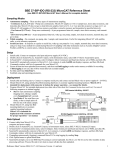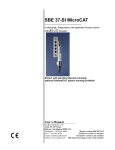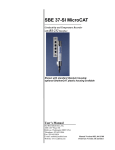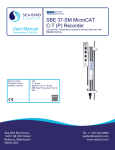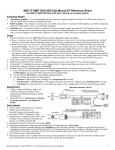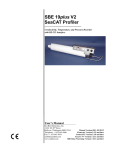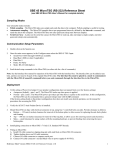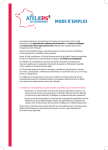Download RS-232 - Sea-Bird Electronics
Transcript
SBE 37-SI (RS-232) MicroCAT Reference Sheet (see SBE 37-SI MicroCAT User’s Manual for complete details) Sampling Modes • • • Autonomous sampling – There are two types of Autonomous sampling. Interval sampling: At pre-programmed intervals, sample and transmit data, and store data in FLASH memory. Continuous sampling: Continuously sample and transmit data, and store data in FLASH memory. Polled sampling – On command, take 1 sample and transmit data. Useful for integrating MicroCAT with satellite, radio, or wire telemetry equipment. Serial Line Sync – In response to a pulse on serial line, sample, transmit data, store data in FLASH memory, and go to sleep. Easy method for integration with Acoustic Doppler Current Profilers (ADCPs) or current meters which can synchronize MicroCAT sampling with their own, without drawing on their battery or memory resources. Setup 1. 2. 3. 4. 5. Install I/O cable; connect to computer serial port and power supply (8.5 - 24 VDC). Double click on SeatermV2.exe. SeatermV2 opens; in Instruments menu, select SBE 37 RS232. Seaterm232 opens. In Seaterm232’s Communications menu, select Configure. Select Comm port and baud rate (factory set to 9600), and click OK. Seaterm232 automatically connects to MicroCAT. As it connects, it sends GetHD and displays response, and then fills Send Commands window with list of commands for your MicroCAT. Program MicroCAT for intended deployment (see other side of this sheet for Command Instructions and List). A. Ensure all data has been uploaded, and then send InitLogging to make entire memory available for recording. If InitLogging is not sent, data will be stored after last recorded sample. B. Set date and time (DateTime=). C. Establish setup and operating parameters. Parameters that control operation include: • SampleMode= SampleMode=1: When commanded to sample, take a single sample. SampleMode=2: When commanded to sample, sample at intervals defined by SampleInterval=. SampleMode=3: When commanded to sample, sample continuously. • AutoRun= AutoRun=Y: When power applied, automatically sample as defined by SampleMode=. AutoRun=N: When power applied, do not begin to automatically sample. Deployment 1. 2. Wiring - Install I/O cable and locking sleeve. Connect to computer serial port and power supply (8.5 - 24 VDC). Deploy MicroCAT, using Sea-Bird mounting hardware or customer-supplied mounting hardware. Data Upload 1. 2. 3. 4. Connect cable from MicroCAT to computer and power source. Double click on SeatermV2.exe. SeatermV2 opens; in Instruments menu, select SBE 37 RS232. Seaterm232 opens. In Seaterm232’s Communications menu, select Configure. Select Comm port and baud rate (factory set to 9600), and click OK. Seaterm232 automatically connects to MicroCAT. As it connects, it sends GetHD and displays response, and then fills Send Commands window with list of commands for your MicroCAT. 5. If sampling autonomously (logging), command MicroCAT to stop logging by sending Stop. 6. Click Upload menu to upload stored data. 7. Seaterm232 prompts you to run SBE Data Processing to convert uploaded .hex file to .cnv file for use by other modules in data processing software. Process file and review data in Sea-Bird data processing software to ensure all data has been uploaded. Reference Sheet Version #014, 03-13-14; Firmware Version 3.1 and later 1 Command Instructions and List • • • • Input commands in upper or lower case letters and register commands by pressing Enter key. If in quiescent (sleep) state, re-establish communications by clicking Connect in Communications menu or pressing Enter key. If a new command is not received within 2 minutes after completion of a command, MicroCAT returns to quiescent (sleep) state. MicroCAT sends an error message if invalid command is entered. Shown below are commands used most commonly in the field. See Manual for complete listing and detailed descriptions. CATEGORY Status COMMAND GetCD GetSD GetCC GetEC ResetEC GetHD DS DC DateTime= mmddyyyyhhmmss DESCRIPTION Get and display configuration data. Get and display status data. Get and display calibration coefficients. Get and display event counter data. Reset event counter. Get and display hardware data. Get and display status. Get and display calibration coefficients. Set real-time clock month, day, year, hour, minute, second. x= baud rate (600, 1200, 2400, 4800, 9600, 19200, 38400, 57600, or 115200). Default 9600. x=N: do not. OutputExecutedTag=x x=Y: output XML Executed and Executing tags. ReferencePressure=x x = reference pressure (decibars) (used when MicroCAT has no pressure sensor). Quit session and place MicroCAT in quiescent (sleep) state. QS x=Y: Store data to FLASH memory when sampling. x=N: do not. StoreData=x Initialize logging to make entire memory available for recording. InitLogging Memory Setup x= sample number for last sample in memory. SampleNumber=0 equivalent to SampleNumber=x InitLogging. x=0: raw decimal data. x=1: converted decimal data. x=2: converted decimal data in XML. x=3: converted binary data. OutputFormat=x x=4: converted decimal data, alternate format. x=5: converted data, BSH format. x=Y: output date and time. x=N: do not. OutputTime=x Output x=Y: output salinity (psu). x=N: do not. OutputSal=x Format x=Y: output sound velocity (m/sec). x=N: do not. OutputSV=x Setup x=Y: output local density (kg/m3). x=N: do not. OutputDensity=x x=Y: output depth (meters). x=N: do not. OutputDepth=x x= latitude (degrees) to use in depth calculation. Latitude=x x=1: When command to sample, take single sample. x=2: When command to sample, sample at intervals defined by SampleInterval=. SampleMode=x x=3: When command to sample, sample continuously. x = interval between samples (6 - 21600 seconds) when SampleMode=2. SampleInterval=x Operating x=Y: When power applied, automatically sample as defined by SampleMode=. AutoRun=x x=N: When power applied, do not begin to automatically sample. Start sampling, as defined by SampleMode=. Start Stop sampling. Must send Stop before uploading data. Stop Take sample, store data in buffer, output data. TS Take sample, store data in buffer, do not output data. TSH Take sample, store data in buffer and in FLASH memory, output data. TSS Polled Sampling Take x samples, output data. TSn:x Output last sample stored in buffer. SL Output last sample stored in buffer, then take new sample and store data in buffer. SLT Upload scan b to scan e, in alternate converted decimal form (OutputFormat=4) DDb,e (regardless of user setup for OutputFormat=). Data Upload Upload scan b to scan e, in format defined by OutputFormat=. GetSamples:b,e Calibration See manual. Coefficients General Setup BaudRate=x Reference Sheet Version #014, 03-13-14; Firmware Version 3.1 and later 2


